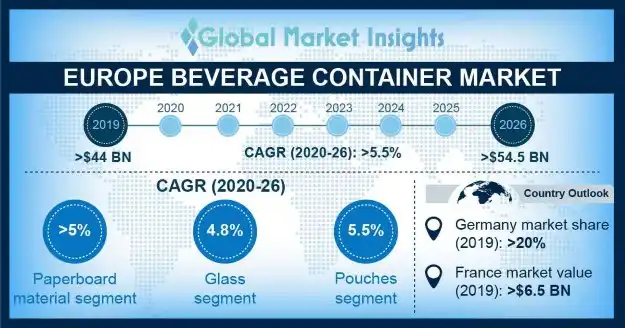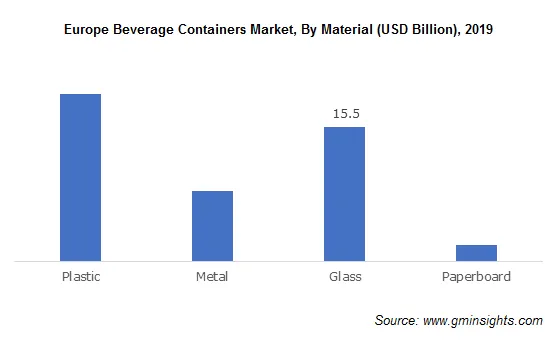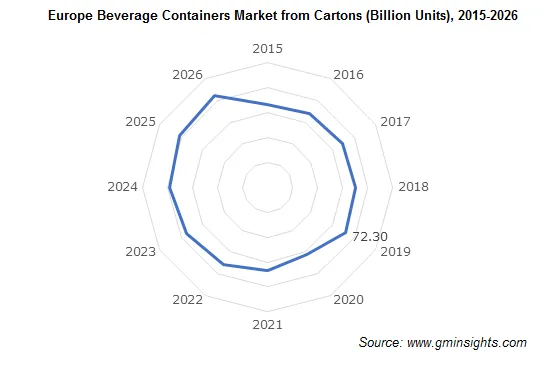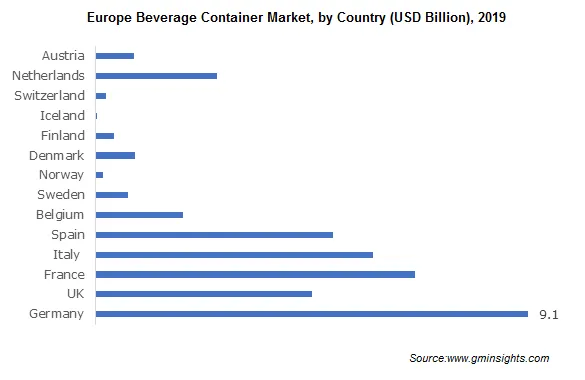Home > Packaging > Consumer Goods Packaging > Food Packaging > Europe Beverage Container Market
Europe Beverage Container Market Size
Europe beverage container market size exceeded USD 44 Billion, globally in 2019 and is estimated to grow at over 5.5% CAGR between 2020 and 2026. Growing demand for aseptic packaging to improve the product shelf life is propelling the industry advancement during the study timeframe.

Positive outlook for the beverage sector accompanied by growing export potential of European alcoholic and non-alcoholic beverages is propelling the Europe beverage container market growth. The food & beverage industry accounts for nearly 15% of Europe’s manufacturing industry owing to rise in local demand along with favorable trade policies. Intra-EU exports contribute to around 25% of the regional F&B industry turnover. Whereas, intra-EU beverage exports is nearly equal to exports to other countries.
| Report Attributes | Details |
|---|---|
| Base Year: | 2019 |
| Market Size in 2019: | 44.7 Billion (USD) |
| Forecast Period: | 2020 to 2026 |
| Forecast Period 2020 to 2026 CAGR: | 5.5% |
| 2026 Value Projection: | 54.5 Billion (USD) |
| Historical Data for: | 2015 to 2018 |
| No. of Pages: | 340 |
| Tables, Charts & Figures: | 298 |
| Segments covered: | Material, Type, Application, Country |
| Growth Drivers: |
|
| Pitfalls & Challenges: |
|
Increasing competitiveness in the beverage industry driven by product innovation in categories such as dairy alternatives, organic beverages, and kombucha accompanied by consumer preference towards new & healthy beverages will generate new growth opportunities. The outbreak of COVID-19 is projected to shift the consumer presence towards products with high fiber, vitamin & minerals for health improvement.
Positive economic outlook, availability of extensive range of beverages, along with penetration of e-commerce distribution network has supported the Europe beverage container market expansion even in times of COVID-19.
Increasing demand for see-through cans & bottles for enhancing the aesthetic appeal of fruit juices, enhanced water, dairy products, and sports & energy drinks will support the Europe beverage container market growth. Technological advancements towards improved heat resistance, acid resistance, and greater shelf life of products will drive the see-through packaging demand over the projected timeframe. Manufacturers are working closely with beverage processors to provide the customized design as per their requirements, thereby enhancing their bargaining power.
Improved raw material recycling rates particularly for glass, plastic, and aluminum owing to supporting schemes by the government has changed the industry dynamics. Government initiatives such as the deposit-return system (DRS) where a surcharge is levied on a product when purchased and a rebate when it is returned, by the European Union has positively influenced the Europe beverage container market.
Manufacturers have been able to reduce their raw material processing costs and gain competitive advantage. However, the revenues for large scale alcoholic and non-alcoholic beverage producers is expected to fall in 2020 owing to lowered exports and supply chain disruptions.
Europe Beverage Container Market Analysis

Glass segment is anticipated to witness CAGR of 4.8% between 2020 to 2026. Glass is odorless, chemically inert, and provides resistance to gases and vapors. Glass is considered as an eco-friendly material where the EU glass recycling rates have increased considerably to nearly 73%. Glass containers need no chemical liners and plastic and are alleged as best for taste and for creating premium and special experiences. The capability of glass to preserve strength, aroma, and flavors of beverages and provide a rich aesthetic appeal makes it the most preferred option for the alcoholic beverages industry.

Cartons hold a considerable volume share in the Europe beverage container market in 2019. Cartons enable safe storage and transportation of beverages and provide customized packaging based on the manufacturer’s marketing requirements. Also, factors such as extended shelf life, minimal wastage, convenience, and lower cost drive the product usage in day-to-day low-cost non-alcoholic beverages such as dairy products and fruit juices. Additionally, the European government support for the use of container materials with a low carbon footprint will significantly propel the demand for beverage cartons.
Pouches segment is anticipated to witness a CAGR of 5.5% in terms of revenue from 2020 to 2026. The increasing popularity of pouches due to its flexibility and easy to handle nature will support segment growth. Expansion in the flexible packaging industry owing to improved barrier properties along with innovations in high-speed filling equipment will drive the Europe beverage container market share. Moreover, aspects such as appropriate sealing and heat insulation, capability to act as a barrier against moisture will provide potential growth prospects.
Alcoholic beverages account for a considerable share in the beverage containers production. Europe is the leading wine producing region in the world and holds nearly 27.3% of the global beer production in 2017. Countries including Germany, the UK, Netherlands, and Spain contribute approx. 38% of the regional beer production, whereas, France, Italy, and Spain account for more than 50% of the global wine production. Positive outlook for beverage exports owing to rise in alcoholic beverages demand across developing economies of Asia Pacific will support the Europe beverage container market segment growth.

Europe beverage containers industry share is highly fragmented with several regional and international players including Tetra Pak, Crown Holdings Incorporated, Amcor, Ardagh Group SA, Ball Corporation, Vidrala, CCL Industries Incorporated, Reynolds Group Holdings Limited, Berry Plastics Corporation, and Mondi Group. The top five manufacturers in the global beverage containers business contributed to around 24% of market share in 2019.
Europe Beverage Container Market Share
Companies are engaged in mergers, acquisition and production capacity expansion for capturing higher market share. For instance, in June 2019, Amcor acquired Bemis Company Inc., a key packaging manufacturer to enhance their production capabilities and geographical footprint.
Some of the players in Europe Beverage Container Market are:
- Ampac Packaging LLC
- Amcor Limited Alcoholic
- Anchor Glass Container Cooperation
- Ardagh Group SA
- Anheuser Busch Inbev
- Ball Corporation
- Berry Plastics Corporation
- CCL Industries Incorporated
- CKS Packaging
- Altium Packaging
- Crown Holdings Incorporated
- Evergreen Packaging LLC
- Exal Group
- Graham Packaging
- Liqui – Box Corporation
- PepsiCo Incorporated
- Reynolds Group Holding Limited
- The Coca-Cola Company
The Europe beverage container market report includes in-depth coverage of the industry trends, with estimates & forecast in terms of volume (Billion Units) and (Billion Liters), and revenue (USD Billion) from 2015 to 2026, for the following segments:
Click here to Buy Section of this Report
By Material
- Plastic
- Metal
- Glass
- Paperboard
By Type
- Bottles & jar
- Cartons
- Cans
- Bag-In-Boxes
- Pouches
- Others (Cups, Tubs, Bowls etc.)
By Application
- Alcoholic Beverages
- Beer
- Wine
- Spirits
- Non-Alcoholic Beverages
- Carbonated Soft Drinks
- Bottled Water
- Dairy
- Juices
- Sports Drinks
- Enhanced Water
- Others
The above information has been provided for the following countries:
By Country
- Germany
- UK
- France
- Italy
- Spain
- Belgium
- Sweden
- Norway
- Denmark
- Finland
- Iceland
- Switzerland
- Netherlands
- Austria
Frequently Asked Questions (FAQ) :